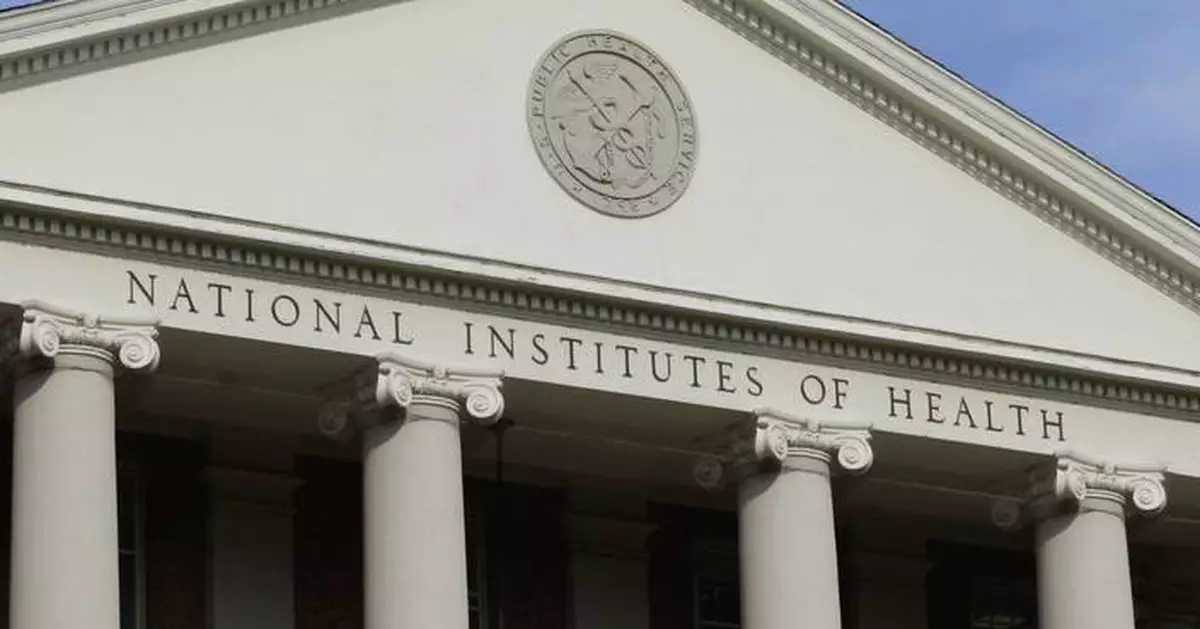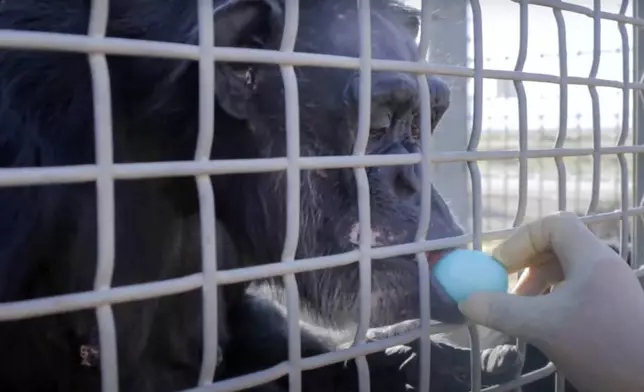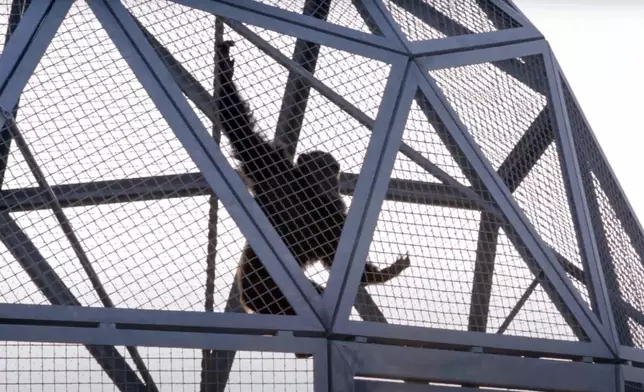ALBUQUERQUE, N.M. (AP) — The National Institutes of Health decided to relocate nearly two dozen retired research chimpanzees from a facility in New Mexico to a sanctuary in Louisiana, a move celebrated Friday by animal advocates who have been fighting for years to get the animals moved.
NIH representatives confirmed in an email that the transfer of the 23 chimps from the Alamogordo Primate Facility at Holloman Air Force Base in southern New Mexico will happen in the coming months.
Click to Gallery
In this image taken from a video provided by the National Institutes of Health, a retired research chimpanzee is given a snack on Oct. 2019, at the Alamogordo Primate Facility in southern N.M. (National Institutes of Health via AP)
This Aug. 29, 2024 image provided by Chimp Haven, shows chimpanzees TJ and Nicole hanging out at a sanctuary near Keithville, La. The two were among a group of chimps previously relocated from the Alamogordo Private Facility at Holloman Air Force Base in southern New Mexico. (Chimp Haven via AP)
In this image taken from a video provided by the National Institutes of Health, a retired research chimpanzee sits in an enclosure, Oct. 2019, at the Alamogordo Primate Facility in southern N.M. (National Institutes of Health via AP)
In this image taken from a video provided by the National Institutes of Health, a retired research chimpanzee hangs in an enclosure, Oct. 2019, at the Alamogordo Primate Facility in southern N.M. (National Institutes of Health via AP)
In this image taken from a video provided by the National Institutes of Health, a retired research chimpanzee eats, Oct. 2019, at the Alamogordo Primate Facility in southern N.M. (National Institutes of Health via AP)
FILE - The administrative building of the National Institutes of Health is shown in Bethesda, Md., Aug. 17, 2009. (AP Photo/J. Scott Applewhite, File)
Staffing issues, namely the planned retirement of the chimps' caretakers, prompted the decision to move the chimps, the agency stated. The animals have not been used as test subjects since 2015, when the NIH retired chimpanzees — humans’ closest relatives — from invasive research.
More than 200 were previously moved to the federally supported sanctuary, but the NIH said it was decided in 2019 that some were too frail to be relocated due to their health conditions. They remained at the base under the care of contracted veterinarians and caregivers.
The contractor informed the NIH that a significant number of staff were expected to retire by July 2025.
“Recruitment and training of new staff has proven difficult due to the specialized nature of the work and APF’s remote location," the NIH statement said. "Given this uncertainty, NIH has determined that the best course of action for the welfare of all these chimpanzees is to relocate them to the federal sanctuary at Chimp Haven.”
Agency spokesperson Amanda Fine said relocating chimpanzees is a complex, time-consuming process and that Chimp Haven will work with the NIH and the facility in Alamogordo to ensure the health and safety of each animal during the move.
The Humane Society of the United States is among the groups that have been sending letters to and petitioning the NIH over the years to relocate the last of the Alamogordo chimps.
The Humane Society of the United States, Animal Protection New Mexico, Humane Society Legislative Fund and others sued the NIH in 2021. A federal judge issued a ruling the next year, finding that the NIH could not legally refuse sanctuary retirement for the chimpanzees because of their chronic health conditions.
“We believe that the extraordinary amount of pressure that has been put on NIH to move them to Chimp Haven -- including the engagement of thousands of our supporters who demanded that the chimps be moved and our winning lawsuit — played a major role in the decision to finally move them to sanctuary,” the group said.
The chimps — which range in age from 34 to 62 years old — could have years ahead of them to enjoy life at the sanctuary, advocates said. The sanctuary has cared for hundreds of chimps since the first two animals arrived there in 2005. That includes 214 that were sent there from NIH-supported facilities following the agency's 2015 decision.
Chimp Haven President and CEO Rana Smith said Friday that the sanctuary is close to capacity and will have to build additional living spaces to accommodate the chimps.
The expansion is expected to cost at least $4 million, which will have to be raised from private supporters.
“There are many details to be determined in the weeks to come, but for now, we celebrate this wonderful news for the APF chimps,” Smith said.
New Mexico was once home to a large colony of captive-bred chimpanzees, with the animals first brought to the state for space travel testing. Later, the colony was acquired by the Coulston Foundation, and expanded for use with drug testing and infectious disease research.
Animal Protection New Mexico has pressed for the chimpanzees’ freedom since the mid-1990s.
“These deserving chimpanzees have endured so much for so long, and their arrival in sanctuary will represent the federal government’s honoring of its obligation and commitment to their retirement,” said Elisabeth Jennings, the group's executive director.

In this image taken from a video provided by the National Institutes of Health, a retired research chimpanzee is given a snack on Oct. 2019, at the Alamogordo Primate Facility in southern N.M. (National Institutes of Health via AP)
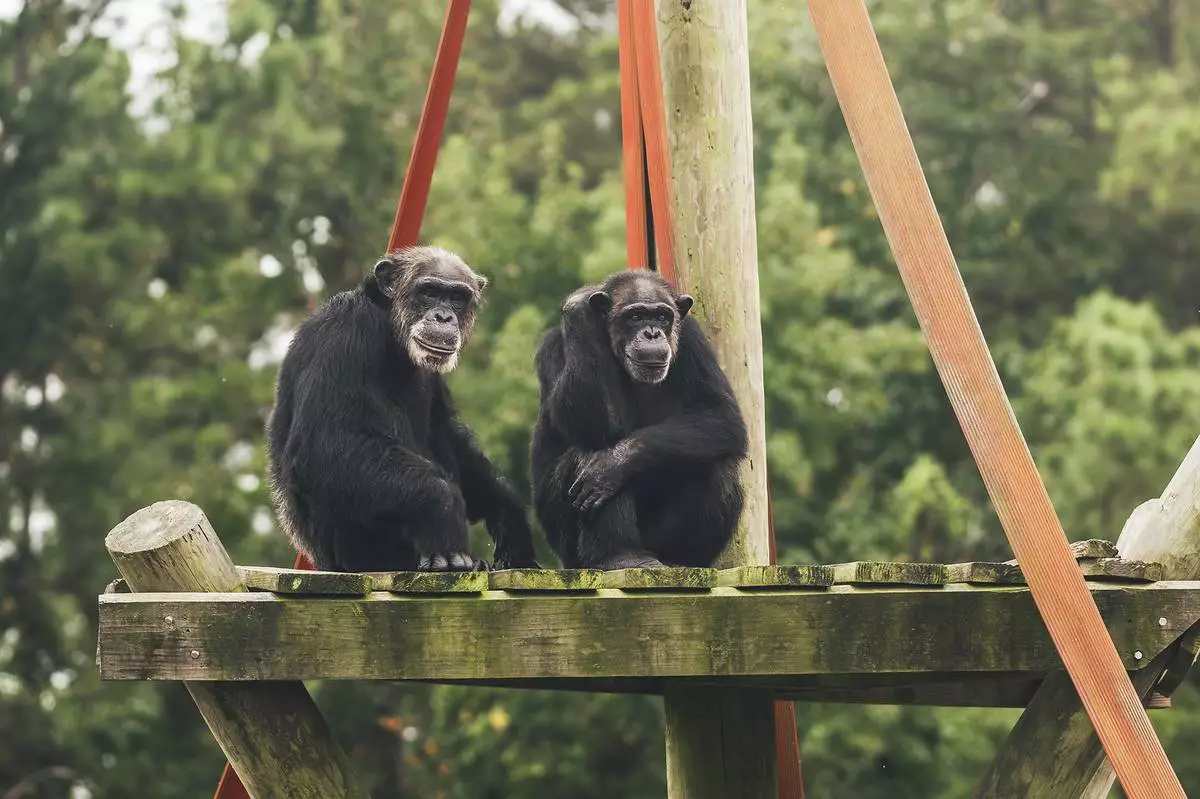
This Aug. 29, 2024 image provided by Chimp Haven, shows chimpanzees TJ and Nicole hanging out at a sanctuary near Keithville, La. The two were among a group of chimps previously relocated from the Alamogordo Private Facility at Holloman Air Force Base in southern New Mexico. (Chimp Haven via AP)
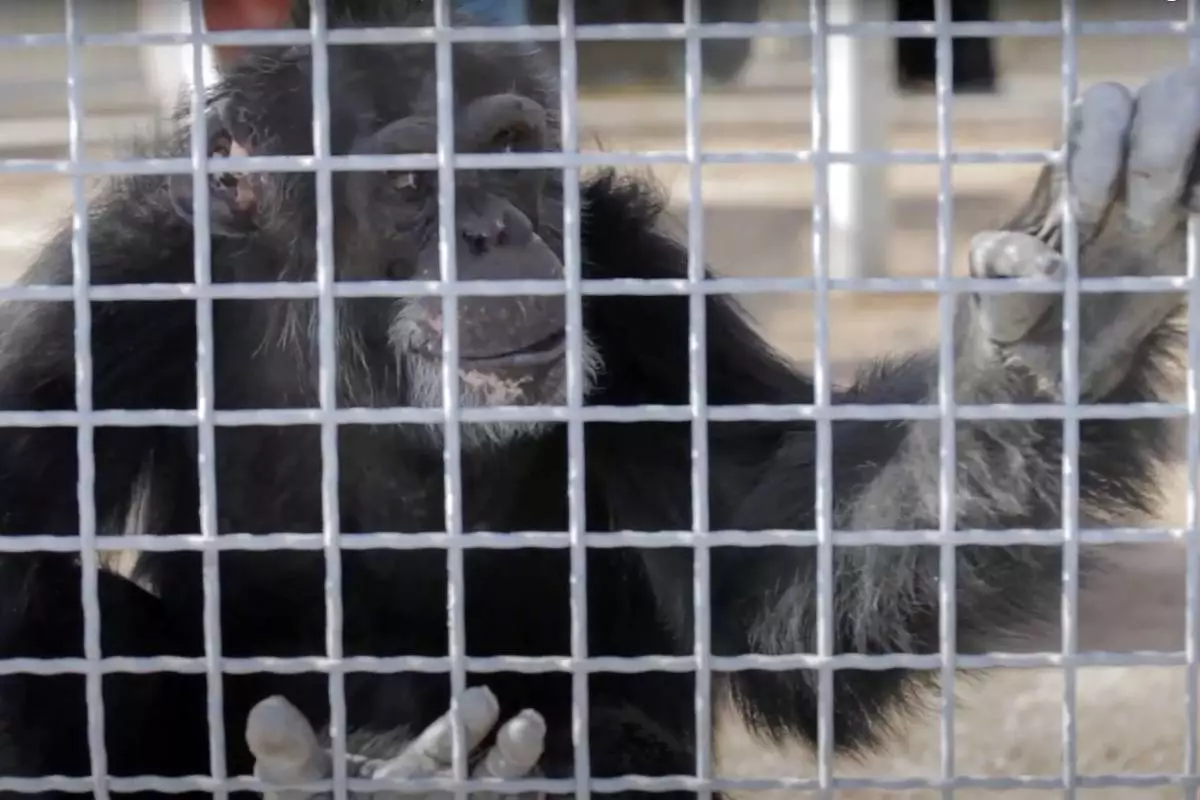
In this image taken from a video provided by the National Institutes of Health, a retired research chimpanzee sits in an enclosure, Oct. 2019, at the Alamogordo Primate Facility in southern N.M. (National Institutes of Health via AP)

In this image taken from a video provided by the National Institutes of Health, a retired research chimpanzee hangs in an enclosure, Oct. 2019, at the Alamogordo Primate Facility in southern N.M. (National Institutes of Health via AP)
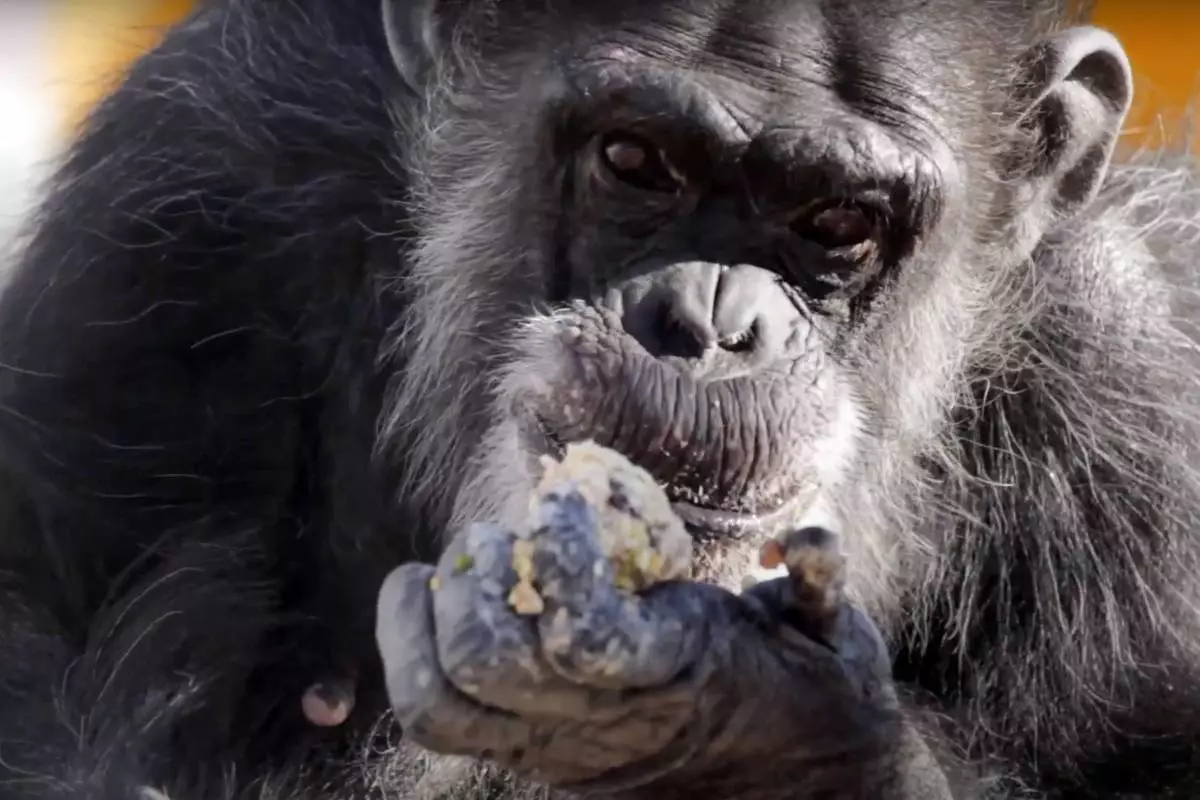
In this image taken from a video provided by the National Institutes of Health, a retired research chimpanzee eats, Oct. 2019, at the Alamogordo Primate Facility in southern N.M. (National Institutes of Health via AP)
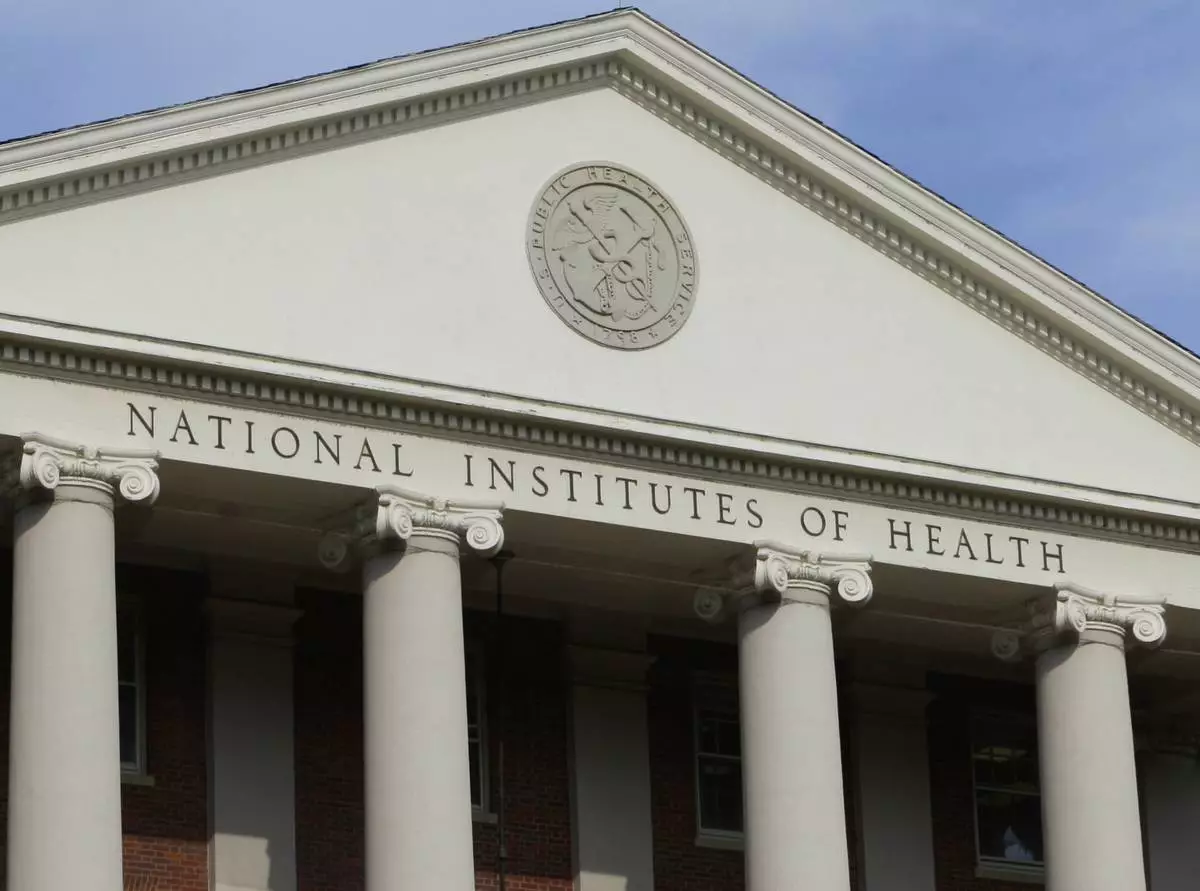
FILE - The administrative building of the National Institutes of Health is shown in Bethesda, Md., Aug. 17, 2009. (AP Photo/J. Scott Applewhite, File)
PHILADELPHIA (AP) — Jalen Hurts may sit out a potential NFC East clincher against Dallas because of the lingering effects of a concussion.
The Eagles could also just rest Hurts to play it safe -- even if he’s medically cleared ahead of Sunday’s game -- and protect their franchise QB from additional injury over the final two games.
Eagles coach Nick Sirianni kept quiet this week on which QB will start Sunday, in large part, of course, because of the head injury suffered by Hurts in last week’s loss to Washington that forced him into the concussion protocol. The issue was complicated by backup Kenny Pickett’s rib injury suffered in relief of Hurts in his first real game competition in nearly a year.
Tanner McKee, the third-string QB, could move into a backup role — or maybe even get the start against the Cowboys.
Philadelphia's starting quarterback situation has surged past Saquon Barkley's chase at Eric Dickerson's season rushing record as the most intriguing talking point in the final two games.
The Eagles (12-3) appear certain to win the division title — they're two games ahead of Washington (10-5) — and a No. 2 seed in the conference no matter the quarterback headed into the playoffs. Even with an unsettled QB spot, the Eagles are are still 7½-point home favorites to beat division rival Dallas, per BetMGM Sportsbook.
Sirianni appreciated that quarterback depth has been a strength for the Eagles.
“We feel good about that room,” he said.
So why risk Hurts against the Cowboys? There's little reason to make Hurts play only a week after absorbing a pair of blows to the head and the extra week off — maybe two if the finale against the Giants is truly meaningless — could add to his recovery time ahead of a home playoff game.
The Eagles were burned in a similar situation last season when Hurts and star wide receiver A.J. Brown were both injured in the final game against the Giants with little at stake. With both players hampered by unnecessary injuries, the Eagles were dumped the next week by Tampa Bay in the NFC wild-card playoff game.
The Eagles have options if Hurts is inactive. Pickett was 14 of 24 for 143 yards in relief, throwing a touchdown pass to Brown and an interception. Pickett, a first-round pick out of Pitt in 2022, went 14-10 as a starter for the Steelers before he was traded to the Eagles in the offseason.
McKee was the Eagles’ 2023 sixth-round pick out of Stanford. The 6-foot-6, 231-pound quarterback has yet to take a snap in a regular-season game. He's mostly used in practice on the scout team or in developmental periods — at best, he'll stay late after practice to get some reps in with the top receivers.
“Every week, every opportunity, it's knowing it could be my shot, my chance,” McKee said.
He could finally get that shot against Dallas.
With the Cowboys out of playoff contention, the questions persist for coach Mike McCarthy about bypassing Cooper Rush for a look at Trey Lance before both QBs hit free agency. McCarthy’s answer hasn’t wavered: Rush gives Dallas the best chance to win.
Rush is 4-3 since Dak Prescott’s season-ending hamstring tear after going 5-1 over two previous stints as an injury replacement.
That’s 9-4 total. Half the losses came in both of Rush’s starts against Eagles – the last of five games filling in during the 2022 season and the first game this season.
“The mindset is to win,” McCarthy said. “We’re going to Philadelphia to win the game.”
Barkley leads the NFL with 1,838 yards rushing for the season through 15 games. He still needs two big outings in the final games of the season against Dallas and the New York Giants to top Dickerson and his 2,105 yards for the Los Angeles Rams in 1984.
Barkley is 268 yards away from passing Dickerson for the season mark and 162 shy from becoming the ninth player in NFL history with 2,000 yards rushing in a season.
He ran for only 66 yards in the first game this season against Dallas.
Dallas ranks 28th in the NFL in rushing defense, surrendering 135.9 yards per contest. Philadelphia, behind Barkley’s stellar play, tops the league at 187.9 yards per game on the ground.
The Eagles have already have set a team record for yards rushing in a season with 2,818, and they are within four rushing touchdowns of tying the club’s single-season mark of 32, set in 2022. Barkley needs four more rushing touchdowns to tie LeSean McCoy’s Eagles record, set in 2011 and just 33 yards from scrimmage to break McCoy’s mark of 2,146 set in 2013.
Star Dallas edge rusher Micah Parsons needs half a sack to reach double digits in each of his first four seasons despite missing four games with a high ankle sprain, the first injury absence of his career.
The 2021 AP Defensive Rookie of the Year would be the fifth player to reach 10 sacks in each of his first four seasons. The other four — Claude Humphrey, Reggie White, Derrick Thomas and Dwight Freeney - are in the Pro Football Hall of Fame.
AP Pro Football Writer Schuyler Dixon contributed from Arlington, Texas.
AP NFL: https://apnews.com/hub/nfl

Dallas Cowboys quarterback Cooper Rush (10) throws a pass under pressure from Tampa Bay Buccaneers linebacker Yaya Diaby (0) in the second half of an NFL football game in Arlington, Texas, Sunday, Dec. 22, 2024. (AP Photo/Julio Cortez)

Dallas Cowboys' Buddy Johnson, left, and Andrew Booth Jr. (25) celebrate with C.J. Goodwin (29) after Goodwin made a stop on a punt coverage in the second half of an NFL football game against the Tampa Bay Buccaneers in Arlington, Texas, Sunday, Dec. 22, 2024. (AP Photo/Julio Cortez)

Tampa Bay Buccaneers wide receiver Mike Evans (13) is slow to get up after being hit by Dallas Cowboys safety Donovan Wilson (6), while trying to catch a pass in the second half of an NFL football game in Arlington, Texas, Sunday, Dec. 22, 2024. (AP Photo/Julio Cortez)

Dallas Cowboys defensive tackle Linval Joseph celebrates a sack of Tampa Bay Buccaneers quarterback Baker Mayfield in the second half of an NFL football game in Arlington, Texas, Sunday, Dec. 22, 2024. (AP Photo/Jeffrey McWhorter)

Philadelphia Eagles running back Saquon Barkley (26) on the field before the start of an NFL football game against the Washington Commanders, Sunday, Dec. 22, 2024, in Landover, Md. (AP Photo/Stephanie Scarbrough)

Philadelphia Eagles running back Saquon Barkley (26) walks back to the bench during the second half of an NFL football game against the Washington Commanders, Sunday, Dec. 22, 2024, in Landover, Md. (AP Photo/Stephanie Scarbrough)

Philadelphia Eagles running back Saquon Barkley (26) celebrating his touchdown with teammate Philadelphia Eagles quarterback Jalen Hurts (1) during the first half of an NFL football game against the Washington Commanders, Sunday, Dec. 22, 2024, in Landover, Md. (AP Photo/Nick Wass)

Philadelphia Eagles running back Saquon Barkley (26) celebrating his touchdown with his teammate Philadelphia Eagles quarterback Jalen Hurts (1) during the first half of an NFL football game against the Washington Commanders, Sunday, Dec. 22, 2024, in Landover, Md. (AP Photo/Stephanie Scarbrough)

Philadelphia Eagles quarterback Jalen Hurts (1) walking off the field during the first half of an NFL football game against the Washington Commanders, Sunday, Dec. 22, 2024, in Landover, Md. (AP Photo/Stephanie Scarbrough)

Philadelphia Eagles quarterback Jalen Hurts (1) running with the ball during the first half of an NFL football game against the Washington Commanders, Sunday, Dec. 22, 2024, in Landover, Md. (AP Photo/Nick Wass)








